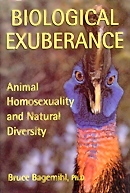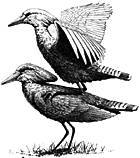
Gay/Lesbian/Feminist Bookstores Around the Country
The Mostly Unfabulous Homepage of Ethan Green
![]()


Why Biological Exuberance?
Author Bruce Bagemihl, Ph. D, Explains the Thoughts Behind the Book
To dispel misinformation and ignorance -- certainly that is a
primary reason why I wrote this book. Many people continue to
believe that homosexuality doesn't occur in nature, and use this
belief to justify their opinions about human homosexuality. Consider
statements such as the following:
"Animals don't do it, so why should we? Can you even imagine a queer grizzly bear? Or a lesbian owl or salmon?"
-- from a letter written to Dean Hamer, co-author of The Science of Desire: The Search for the Gay Gene and the Biology of Behavior (1994, Simon & Schuster)
In fact, not only has homosexual behavior of various types been scientifically documented in hundreds of animal species worldwide -- it occurs in the very animals singled out by this letter-writer. Same-sex pair-bonding and co-parenting are found in Grizzly Bears and Barn Owls, and homosexual courtship and sexual activity in several species of Salmon.
 |
| A female Hammerhead mounting another female Illustration by John Megahan, © 1999. |
Also, because a comprehensive book on this topic has not yet appeared within the scientific literature, I wanted to make sure that the material was presented in as accurate, complete, objective, and documented form as possible. This included stripping many of the original zoological descriptions of their biased, negative, and overtly homophobic (and heterosexist) language and interpretations -- and discussing how these biases have affected the study of the subject.
But more than simply offering the data and documentation, I wanted to bring the animals, their social contexts, and their activities to life with vivid descriptions and illustrations. I began researching this book nearly ten years ago, and close to two years of this project alone were devoted to compiling the visual materials. This included tracking down rare photographs of homosexual activity in animals >from all over the world, and working with the book's superb illustrator, John Megahan, to create the drawings and ensure their accuracy.
On the other hand, I also wrote Biological Exuberance to expose and challenge the limitations of the "nature vs. nurture" debate. Too many times, evidence of homosexuality in animals is used to support the idea that homosexuality is entirely biologically determined, genetically controlled, or otherwise fixed at (or before) birth -- and more broadly, to argue for its "naturalness" in people. In the process, the complexities and nuances of sexual orientation and gender -- in both animals and humans -- are overlooked.
This book shows how social, environmental, cultural, geographic, and individual factors also come into play in the expression of homosexuality in animals. In other words, both "nurture" and "nature" are relevant, even in a nonhuman context. If nothing more, then, I want readers to understand that it is overly simplistic to equate homosexuality in animals with its "naturalness" or automatic "acceptability" in people.
Finally, Biological Exuberance is about far more than animal (homo)sexuality -- it presents a new vision of the world and our position in it. Much of the discourse on animal homosexuality -- both scientific and popular -- has floundered in attempts to find an "explanation" for the phenomenon or fit it into traditional theories of evolution. I suggest in this book that such attempts, while useful up to a point, are ultimately misguided. What is needed is not yet another simplistic "answer", but an expanded concept of what is possible.
In Biological Exuberance I chart a number of courses to this new mode of perception-- courses that, while speculative at times, offer the possibility for a breakthrough in understanding. Ultimately, this book is a meditation on the nature of life itself, and a celebration of its paradoxes and pluralities. I hope readers will come away from Biological Exuberance with a (renewed) sense of wonder about the world and a deeper appreciation of their own lives.
Sounds good, right? Read more:
- Intro, Biological Exuberance: Now that's a wild kingdom.
- Formidable Fathers and Supernormal Mothers: Queer animals make great parents.
- Ritual: Guess which humal ritual began as monkey diddling.
- The Perversion of Scientific Discourse: Why would some experts call animals "immoral" or "sinful."
- Biodiversity = Sexual Diversity: Why sexual diversity is essential to survival.
Copyright © 1999 Bruce Bagemihl.
 Back
to the Stonewall Inn
Back
to the Stonewall Inn 